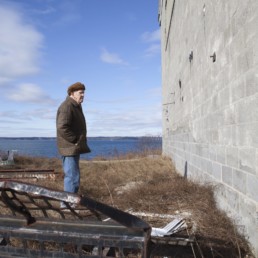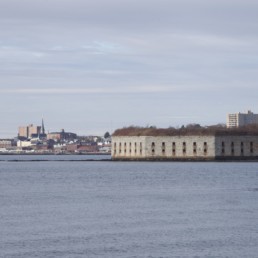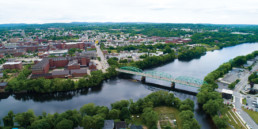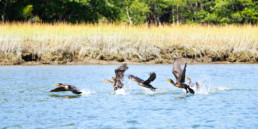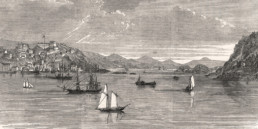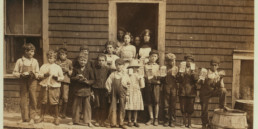World War II Left a Big Footprint on Casco Bay Islands
BY EDGAR ALLEN BEEM
The great concrete bulwark of Battery Steele on Peaks Island is covered in earth and weeds and graffiti. The maw of the old gun emplacement stands dark, dank, and toothless, its 16-inch battleship guns removed a lifetime ago. On the face of the fortification someone has painted the words “American Heartache” in garish blue and pink letters.
Standing forlorn and neglected in a landscape of cattail and bittersweet populated mostly by raccoons and beavers, the abandoned artillery fortification, 18-inch-thick steel-reinforced concrete with a 300-foot-long tunnel down the middle, has the look and feel of an ancient ruin.
Kimberly MacIsaac, a Peaks Island native and former director of the island’s Fifth Maine Regiment Museum, conducts guided tours of the island’s military structures.
“This was our playground growing up,” says MacIsaac, steering a golf cart into the cavernous battery. “This is where we hung out, in the forts.”
The great guns at Battery Steele, with a range of 26 miles, were meant to protect the Maine coast from Popham near Bath to Kennebunkport, but they were never fired in anger. When they were fired, however, everyone on the island knew it.
“They were test-fired with about three-quarters of a charge,” says MacIsaac. “You could feel the vibration all over the island. A few windowpanes would break. My aunt told me she was making spaghetti sauce once when the guns were fired and it splattered all over the kitchen.”
Seven decades later, it would be hard for most people to imagine that during World War II, Peaks Island—and, indeed, all of Casco Bay—was a hotbed of military activity. There were 58 military structures on Peaks alone, ranging from gun emplacements and watchtowers to range-finding bunkers, fire-control posts, barracks, and searchlight bases.
World War II left a heavy footprint on some of the islands in the form of abandoned buildings, bunkers, and bases. Some have become eyesores, some have been renovated for new uses, and some are treated as local landmarks, but all are present and physical reminders of a history that should not be forgotten.
Coastal Defense
The coast and islands of Casco Bay are encrusted with the remains of old forts meant to defend Portland Harbor and the bay against all manner of enemies, foreign and domestic. One of the most prominent, the truncated octagon of Fort Gorges on Hog Island Ledge in the middle of the harbor, dates to the Civil War, but it was not completed before that war ended. Many of the forts along the shore, from Fort Williams in Cape Elizabeth and Fort Preble in South Portland to Fort Levett on Cushing Island and Fort McKinley on Great Diamond Island, date to the late 19th and early 20th century, but they were pressed into service during World War II, often updated with new artillery and antiaircraft guns.
In 1942, military reservations were installed on Cape Elizabeth, Peaks Island, Jewell Island, Long Island, Bailey Island, and Chebeague Island. By 1944, the US Army Coast Artillery Corps had 1,753 enlisted men and 130 officers assigned to defend Portland Harbor and Casco Bay. Nine hundred of those soldiers were based on Peaks, outnumbering the 700 islanders.
Military history is everywhere on Peaks. As Kim MacIsaac’s golf cart bumps along the island’s back roads, she points out the overgrown remains of searchlights and watchtowers, generator buildings and gun emplacements. Here, a former army barracks has been resurrected as a summer cottage. A veritable mansion has been constructed atop Battery Craven, which once housed a pair of six-inch guns with a 15-mile range. There, a mine casement facility known locally as “Big Daddy” has been turned into a cottage. And a range-finding station called “Little Momma,” once hidden inside a cottage, now stands naked and alone overlooking the cold North Atlantic.
During the war, large areas of the bay were off-limits to fishermen, access to the seaward side of Peaks Island was severely restricted by fences, gates, and guardhouses, and even the shore was forbidden.
“Dirt was mounded up in a berm,” says MacIsaac, pulling over on Seashore Avenue. “You couldn’t get out on the rocks.”
In World War II, the enemy was out to sea. German U-boats patrolled the Atlantic in deadly packs. In 1940, 4,407 Allied ships were sunk in the Atlantic.
There were 58 military structures on Peaks alone, ranging from gun emplacements and watchtowers to range-finding bunkers, fire-control posts, barracks, and searchlight bases.

The South Portland Shipyard
The United States did not officially enter World War II until December 8, 1941, the day after the Japanese attack on Pearl Harbor. But the war came to Casco Bay a year earlier when the shipyard in South Portland began building ships for the British.
“Portland was an exciting place during the war,” says historian Joel Eastman. “There was just so much going on. People came from all over the country to work in the shipyards.”
In 1940, the Todd-Bath Iron Shipbuilding Corporation opened the East Yard on the South Portland waterfront. In 1941, the US Maritime Commission called for a second shipyard, run by the South Portland Shipbuilding Corporation and referred to as the West Yard. In 1943, the two yards merged as the New England Shipbuilding Corporation.
The first British ship was launched from the East Yard in March of 1942. The last Liberty ship was launched in October 1945. Between those dates, some 30,000 shipyard workers built 266 Liberty ships in South Portland for the war effort.
In a chapter in Creating Portland, on Portland during the Depression and World War II, Eastman, emeritus professor of history at the University of Southern Maine, describes how the war pulled the city and the region out of economic decline by providing work. The population of Portland grew by 10,000 between 1940 and 1950.
With the influx of soldiers, sailors, and shipyard workers, Portland became a pretty rowdy liberty port as well. Eastman records, for example, that in March of 1943 Portland police criticized navy shore patrol for not helping to break up fights among navy men. A few days later, 1,500 shipyard workers rioted at a Portland theater when a striptease show ended unexpectedly.
But Eastman writes that “By the fall of 1944, the greater Portland area had adjusted to the impact of the shipyards, the army, and the navy, three and half years after their arrival.”
Sitting in Becky’s Diner on the Portland waterfront some 70 years after the fact, Eastman assesses the military history of Casco Bay by observing, “The navy is more important than the forts, because ‘Destroyer Atlantic’ was in Portland throughout the war. Every vessel in the Atlantic fleet came to Portland during the war.”
Naval Operations
Commander Destroyer Force, Atlantic (ComDesLant) chose Casco Bay as its base during World War II because it offered protected anchorage close to North Atlantic convoy routes. Captain George Stewart, a retired US Navy captain and marine engineer who grew up spending summers on Peaks Island, has posted a four-part report entitled “Going Ashore: Naval Operations in Casco Bay During World War II” on the Naval Historical Foundation website.
To date, Stewart’s research has identified 808 ships that visited Portland during the war, but the daily comings and goings of naval vessels, as well as ships from South Portland on sea trials, created levels of marine traffic in Portland Harbor and Casco Bay that would be unimaginable today. During one week in August of 1944, for example, 539 ships arrived and 558 ships departed. In comparison, during one week in November of 2014, just 70 vessels—fishing boats, ferries, tugs, and tankers—arrived in port.
Stewart remembers tagging along with his uncle Harry Wallace as he piloted army transport boats between the harbor and island forts. He recalls the bay being incredibly crowded and polluted with oil slicks everywhere along the shore.
“We did not have access to the waterfront on the seaward side of Peaks,” says Stewart. “That was cordoned off.”
Not only were the big guns of Battery Steele mounted on the back shore of the island, but a sophisticated network of submarine nets, minefields, hydrophones, and magnetic submarine indicator loops on the ocean floor monitored sea traffic and controlled access to Casco Bay. Though none of the harbor-defense guns in Casco Bay were ever fired at an enemy, the threat from the sea was real. And despite the elaborate anti-sub defenses laid out around Casco Bay, on April 23, 1945, German submarine U-853 managed to sink the uss eagle, a patrol boat towing targets for navy bombers off Cape Elizabeth. Fifty-four of the 67 crewmen were killed.
The two primary focuses of naval operations in Casco Bay during World War II were training and refueling. One of the few vestiges of navy training is a rusted steel box that sits on the shore of Little Chebeague Island. Designed to simulate a ship’s engine room, the steel box was the classroom of the Navy Firefighting School.
“In the last two years of the war, they trained 1,500 sailors in shipboard firefighting,” says Erno Bonebakker, a Portland resident and Chebeague Island summer resident who is writing a history of World War II on Casco Bay.
While the brick and concrete forts dotting the shore are visible reminders of the army’s coastal defense operations, relics of naval operations are more subtle—unless you know where to look.
Long Island Fuel Annex
The entire waterfront of modern-day Long Island from Ponce’s Landing to Doughty’s Landing is essentially navy surplus. Long Island was the hub of naval activities in the bay, home to the US Navy Fuel Annex, Torpedo Control Officers School, and the US Naval Air Facility Casco Bay.
As Casco Bay Lines ferries approach Long Island, the two largest onshore structures are the great empty concrete hulk of the old navy boiler plant and the navy’s former small boat maintenance facility, which now houses an auto repair shop, boat storage, and a variety store. The long, low buildings along Wharf Street, including Long Island Town Hall, were also left behind by the US Navy.
Just three miles long by one mile wide, Long Island was essentially partitioned during the war, with the navy commandeering the center section of the island for a fuel tank farm. Islanders and summer cottagers were relegated to the far ends of the island. Remnants of the island’s past as a military reservation include not only the buildings along the waterfront, but also a dilapidated marine barracks, an unused guardhouse, a generator building, a litter of fences and fence posts running through the woods, and 15 empty underground fuel tanks.
Donald McVane, an island fisherman who still lives in the house where he was born 87 years ago, was a teenager when the war came to Long Island.
“We went from a quiet little summer resort island to crazy,” recalls McVane. “It was the end of the Depression. The native islanders, with the exception of two or three lobstermen who were better off, were very poor. The war meant jobs.”
But the war also meant that some islanders lost their homes. Sharon Doughty Marr was just an infant when her family came home one day to find a barricade erected in front of their home and an order to vacate the premises posted on the door. The navy was taking it by eminent domain.
“The war had a huge impact on a little place like this,” says Marr. “Many families moved away because of it. We had people leave, but we also had navy people who stayed. We became friends with a lot of navy kids. The school was overloaded.”
Marr recalls how the island fishermen all had large numbers painted on their boats so the military could readily identify them. Though some lobstermen set traps in among the anchored fleet, others chose to fish in the open ocean outside the sub nets.
Three of Marr’s Doughty relatives from Chebeague are thought to be among the very few casualties of the war in Casco Bay. Captain Sidney Doughty and his sons Sidney Jr. and Roger set out one day in 1942 in their new fishing boat marlene and were never seen again.
“The story I always heard,” says Marr, “was they may have had a run-in with a submarine. They never found anything.”
In 1942, 8,245 Allied vessels were sunk in the Atlantic. Those numbers dropped precipitously the following year.
“Much of the reason for the 1943 turnaround during the Battle of the Atlantic,” writes George Stewart in his history of naval operations on Casco Bay, “was the effectiveness of hunter-killer groups.”
Hunter-killer groups consisted of destroyers and escort carriers that could launch planes to locate U-boats that the destroyers would then seek and destroy. Many of these ships set out to sea from Casco Bay.
“The hunter-killer groups were a vital part of winning the Battle of the Atlantic,” says Stewart. “The U-boats had what they called their ‘happy time’ in the early 1940s when they ran wild along the East Coast. That all changed after we got all our ships out there.”
Ship-aircraft operations helped to turn the tide of the war in the Atlantic. In the fall of 1942, the navy built a seaplane ramp and hangar at Doughty’s Landing on Long Island.
“The fishermen on the island told them not to put the landing field there because of the prevailing winds,” says Sharon Marr, “but the government didn’t listen. The first plane that landed there crashed.”
US Naval Air Facility Casco Bay, which for a short time was also used to launch drones as target practice for visiting ships, is now Johnson’s Boatyard. The cement footprint of the hangar remains, and the in-ground tie-downs are used to secure boats rather than planes.
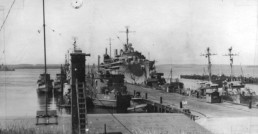
In the Wake of War
World War II departed Casco Bay as fast as it had arrived. Convoys of troops and their navy escorts fueled up and headed out across the North Atlantic for the 1944 D-Day landing. Just a year or so later, the hundreds of ships and thousands of military personnel and shipyard workers who contributed to the war effort began to drift away, and with them went the jobs that had pulled the country out of the Depression.
“When the war ended, nobody expected it,” recalls Donald McVane. “Everyone was planning on another year or two of war because of Japan. Then we dropped the atomic bomb.”
The advent of the atomic age—long-range bombers and nuclear missiles—rendered fixed harbor defense such as those rimming the shores of Casco Bay and the islands obsolete. The Coast Artillery was abolished in 1948, and the forts were disarmed and consigned to uncertain fates. Jewell Island, Two Lights, Fort Preble, Fort Gorges, Fort Williams, and portions of Peaks Island were acquired as public and park land. Fort McKinley on Great Diamond Island stood empty for 30 years before being redeveloped as an upscale resort community.
Out on Long Island, it took even longer to recover from war.
“One of the things you kept hearing at the beginning of the war,” says McVane, “was that after the war everybody would have a chance to buy back their property. That was pie in the sky.”
In 1946, the Long Island Fuel Annex was designated an emergency fuel depot. There was a flurry of activity occasioned by the Cuban Missile Crisis in 1962, but that same year, the annex was placed on caretaker status. The US Navy kept a maintenance crew on the island until 1967, when the fuel annex was sold to King Resources as an oil tank farm. After a long and stormy history, the former military installation was sold to Northland Development, which placed some land in conservation and created a large-lot subdivision. But from 1942 until roughly 1996, Long Islanders were denied access to the heart of their island.
In 1957, a wildfire raced across Peaks Island, destroying all but a dozen of the military buildings. Battery Steele, the most prominent and important of the island’s World War II relics, has served as a dumping ground, concert stage, and art venue. Over the years there have been proposals to convert the site into a mushroom farm, an international hotel and conference center, a wind farm, and an organic garden, but Battery Steele, maintained by the Peaks Island Land Preserve, remains undeveloped. And that’s the way islanders want it.
“People out here don’t want much more building,” says former museum director Kimberly MacIsaac. “The resources can’t take it.”
On Long Island, Sharon Marr sees the island’s military legacy as a mixed blessing. On the one hand, all the buildings lend the island an air of faded glory; on the other, since Long Island declared its independence from Portland in 1993 and became a town, it has been able to make good use of some of the old navy buildings.
“The fire barn we have, the town hall, the recreation building, even the school, were put up by the government,” says Marr. “Because of the underground oil tanks, the center of the island is a conservation area. It would be all house lots if we hadn’t had the navy there.”
“We made the best of a bad situation,” agrees Donald McVane. “The land up there is filled with empty oil tanks, but it’s a nice area now.”
As World War II fades from living memory, the role that Casco Bay played in protecting the coast, providing the ships, hunting the subs, and mounting the invasion is easy to forget. But the islands remember. Landscapes punctuated by war surplus buildings and bunkers are a constant reminder that something historic happened there long ago.
“When you see how small we are,” says Sharon Marr, “it’s amazing the impact we had on that war.”

